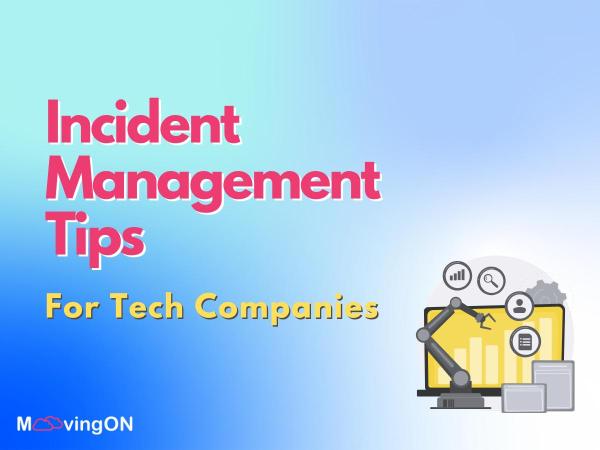Incident Management: Tips for Tech Companies
A seemingly straightforward technical problem can often have explosive consequences. Say a tech team restarts a cloud server overnight; those few minutes of downtime might trigger a problem elsewhere and cause your app to crash. The following morning, customers can’t access your services, you’re trending on social media for all the wrong reasons and your customer service reps are left to pick up the pieces.
Scenarios like this prove the value of incident management. But you need best practices that ensure incident management does what it’s supposed to do. Otherwise, it’s just another buzzword. Here are some best practices for incident management that you need to incorporate into your tech organization.
Use a Proactive Approach
Incident management isn’t about responding to an incident in the heat of the moment and hoping for the best. It’s about having tools and processes in place so you can treat and manage any incident quickly. It’s about being prepared — so you can fix a problem with the least amount of damage.
One way to do this is to be proactive rather than reactive. Successful organizations constantly monitor what’s affecting their cloud infrastructure and application so they can identify problems, respond to those issues quickly and minimize the adverse impact on their operations.
When you’re proactive, you have a better handle on preventing adverse situations before they impact customer experience, helping you plan for the future. You know exactly what to do if the worst-case scenario happens, which provides you with peace of mind.
Being proactive, however, doesn’t mean you just have to think about the future. Incident retrospectives or postmortems, where you review and investigate previous incidents, can help you gain new knowledge and provide you with a new perspective on incident management.
Automate Incident Monitoring
While ongoing monitoring of any kind is invaluable for proactively managing incidents, it can zap labor and resources in your organization. That’s why you should automate as much as you can so you can focus on a major incident without having to complete other tasks simultaneously.
Cloud monitoring tools review, observe and manage cloud-based workloads and services like websites, servers, and applications. These tools speed up your incident response because they notify an administrator about a potential problem, allowing you to act quickly and prevent an incident from damaging your reputation.
You can also automate the remediation process in various ways for consistency. A runbook (or playbook), for example, is a set of predefined steps that defines how you should handle, resolve, and communicate each process in an incident. Managing runbooks, however, can be a challenge for many organizations.
Moovingon.ai helps you improve incident management in your organization with a centralized platform for all your cloud operations. The platform’s automations, runbook management, advanced analytics, and more can help you respond to every situation quickly.
Prioritize Incidents Based on Impact
Whether you use automated tools or not, you need to prioritize incidents based on the potential damage they can do to your organization.
When you identify an incident, ask yourself these questions:
- What are the potential risks of that incident?
- Who will the incident impact?
- Will the incident impact our reputation?
- Will the incident impact our revenue?
- Do I need to address this problem immediately?
In some cases, you might only have a few minutes to answer these questions. Otherwise, an incident can destroy your cloud-based operations.
Assessing the potential impact and risks of every single incident, no matter how small, will help you protect your assets and prevent an incident from jeopardizing your business’ reputation.
Communicate With Your Organization
You should communicate with your entire organization not just after an incident but during all those quiet periods when your cloud infrastructure is operating just fine. That means regular meetings where you discuss upcoming architecture changes and deployments or industry trends that might impact your specific infrastructure so you can plan for every possible outcome.
That also means creating a roadmap for escalating information about an incident based on its severity. If a potential incident has the potential to become a major outage, share this information with non-technical managers, other members of the C-suite and even other departments. A cross-organizational approach to incident management can help you prepare for any eventuality. For example, communicating incident information to your PR or marketing team can help them communicate an incident response to your customers or other stakeholders if you experience downtime or loss of service. The right messaging via a press release or social media update can restore your reputation and help you retain customers.
You should also delegate specific incident management tasks to different team members. The right software can simplify responsibilities across your teams with tiered escalation policies that notify the right people at the right time via channels such as phone, SMS, MSTeams and Slack.
Bottom Line
You already know the ramifications that an incident of great magnitude can cause in your organization. So using these best practices will optimize your incident management processes and put you in the best position to reduce risk, mitigate adverse impacts on your operations and resume service operations as quickly as possible.
Incident management, however, isn’t enough to protect your organization from potential hazards. That’s because it attempts to resolve the negative impacts of an incident without identifying the root cause of the problem. Incident management might fix a problem, but what happens if the same thing happens again? What happens if the incident is worse next time? Learn what you can do to completely safeguard your organization from incidents here!

